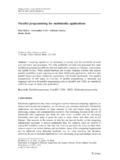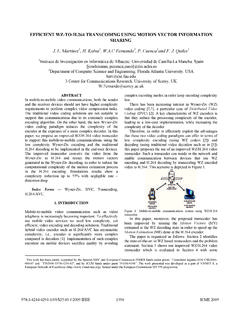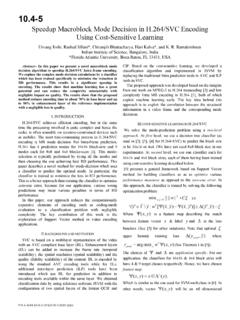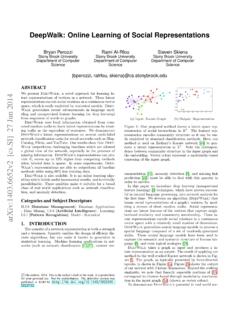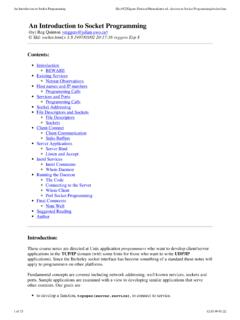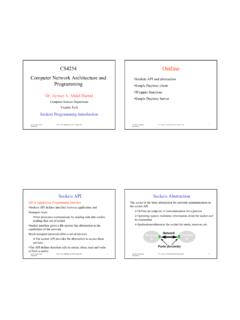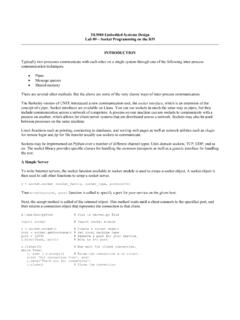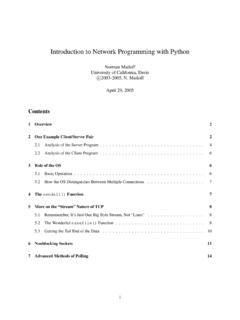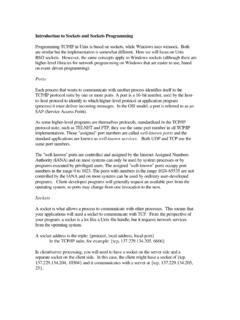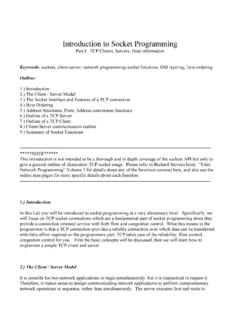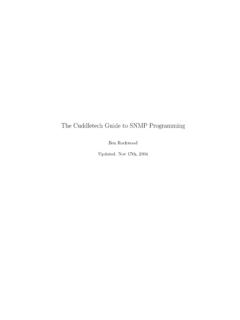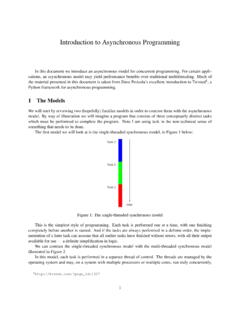Transcription of Computer Network Programming Intro to Sockets
1 Computer Network ProgrammingIntro to SocketsDr. Sam HsuComputer Science & EngineeringFlorida Atlantic University2 Intro to Sockets The Client/Server Model Layered Network Structure Sockets Internet Addressing Protocol Port Numbers Socket Programming Network Byte Order Connectionless/Connection-oriented Examples3 The Client/Server ModelrequestresponseClientClientServerCl oses server connection. Closes client connection.(Goes back to sleep: iterative).Waits for server reply, sends results to user, sends another user request ..Handles client request, sends back reply ..Upon receiving user request,contacts server, sends request on user s contacted by client, calls/creates a handler to handle. (Goes back to sleep: concurrent)Waits for user to sleep waiting for client to and and on an LAN5 Client/Server via a WAN6 OSI vs. Internet Protocol Layers 7 Protocol Data and HeadersSocket StructUser DataTCP/UDPH eaderTCP/UDP DataIPHeaderIP DataFrameHeaderNetwork Frame DataFrameTail(Link) (Internet/ Network )(Transport)Socket LayerTCP or UDP LayerNetwork Layer (Application)IP Layer8 What Is A Socket?
2 (1/2) A socket is a communication end point. Is equivalent to a Computer 's Network (hardware) interface. Allows a Network application to "plug into" the Network (not physically, but metaphorically).9 What Is A Socket? (2/2) Is a Network Programming interface. It is used for interprocess communicationover the Network . It is used by a process to communicate with a remote system via a transport protocol. It needs an IP address and a port Came From Berkeley UNIX Sockets were first introduced in Berkeley UNIX. An extension of the UNIX abstraction of file I/O concepts. Now are commonly supported in almost all modern operating systems for inter-systems communications. 11 Popular in Client/Server Computing Sockets are popularly used in client/server computing. Provides two major types of services: Connection-oriented Connectionless12 Connection-Oriented Services (1/2) Implemented on TCP Short for Transmission Control Protocol. A connection-oriented protocol.
3 Data transfer unit is known as segment. An end-to-end connection is established before data exchange can happen. Similar to our phone Services (2/2) Data bytes are delivered in sequence. Delivery of data is guaranteed. Connection is terminated when finished. There are two modes: Iterative (synchronous) Concurrent (asynchronous)14 Connectionless Services (1/2) Implemented on UDP Short for User Datagram Protocol. A connectionless protocol. Data transfer unit is known as datagram. No connection is required before data transfer. Similar to our postal Services (2/2) Data bytes may be missing or delivered out-of-order. There are also two modes: Iterative (synchronous) Concurrent (asynchronous)16 Sockets Are Bi-directional A socket provides a bi-directional communication mechanism. Two way simultaneously. Also know as full duplex(FDX) Addressing A means to identify hosts on the Internet. There are two popular ways: Using IP addresses. Using the domain name system (DNS).
4 18IP Addresses (1/2) IP is short for Internet Protocol. Each host on the Internet is assigned a 32-bit unique address (in current IPv4). An IP address is assigned to a single host only. A host may have more than one IP address (multi-homed host).19IP Addresses (2/2) Dotted representation Internet addresses are represented in the form of four integers separated by decimal points known as dotted representation. Examples: For readability by Domain Name System (1/2) A high-level naming scheme A sequence of characters grouped into sections delimited by decimal points. Labeled in a meaningful way. Examples: Domain Name System (2/2) The DNS naming convention is hierarchical. Written in the local-most level first and the top-most level last fashion. It is much easier to deal with DNS names than with IP DNS to IP Addresses Delivery of information across the Internet is done by using IP addresses. Need to map DNS names to IP addresses before delivery.
5 Three ways: Done at system startup. Via a local table lookup. Going through a nameserver23 Port Numbers A (protocol) port is an abstraction used by TCP/UDP to distinguish applications on a given host. A port is identified by a 16-bit integer known as the port number. Three ranges of port numbers: Well-known ports Registered ports Dynamic ports24 Well-known Ports Port numbers ranging from 0 to 1,023. A set of pre-assigned port numbers for specific uses. Port numbers are managed by ICANN. Short for the Internet Corporation for Assigned Names and Numbers (ICANN) Used to be controlled solely by IANA (Internet Assigned Numbers Authority).25 Some Well-known PortsFile Transfer Protocol (data)FTP-DATA20 Post Office Protocol Vers. Mail ServiceX400103 NIC Host Name ServerHOSTNAME101 HyperText Transfer ProtocolHTTP80 FingerFINGER79 Bootstrap ProtocolBOOTP67 Domain Name ServerDNS53 Simple Mail Transport ProtocolSMTP25 Terminal ConnectionTELNET23 Secure ShellSSH22 File Transfer Protocol (control)FTP21 Returns the date and the timeDAYTIME13 Echoes a received datagram to the senderECHO7 Reserved0 DescriptionKeywordPort26 Registered Ports Port numbers ranging from 1,024 to 49,151.
6 Not assigned or controlled by ICANN; however their uses need to be registered via an ICANN-accredited registrar to prevent duplications. 27 Dynamic Ports Port numbers ranging from 49,152 to 65,535. Neither assigned or registered. They can be used by anyone. These are ephemeral ports. Also known as private ports. 28 Socket Programming To use a socket, one needs a structure to hold address and its associated port number information. A generic socket format:(address family, address in the family) Another name for familyis Socket Address Structurestruct sockaddr { sa_family_t sa_family; /* address family */char sa_data[14]; /* socket address */} Note: This generic socket structure is primarily for declaring variables. cast is needed in the actual use of a socket address Popular BSD-derived Socket Implementation (1/3)struct sockaddr_in { sa_family_t sin_family; /* address family: AF_XXX */in_port_t sin_port; /* 16-bit protocol port number */struct in_addr sin_addr; /* IP addr in NW byte order */char sin_zero[8]; /* unused, set to zero */} Note: One may encounter PF_XXX occasionally.
7 It is the same as AF_XXX at present, but is expected to be phased out Popular BSD-derived Socket Implementation (2/3)Where sa_family_t sin_familyusually holds the value eitherAF_INETorAF_UNIX. in_port_t sin_portis a 16-bit TCP or UDP port number. In need of htons()to convert to Network byte Popular BSD-derived Socket Implementation (3/3) in_addr sin_addrcontains a 32-bit IPv4 address. Structure forin_addr:struct in_addr { in_addr_t s_addr; /* 32-bit IPv4 address *//* in Network byte order */ } In need of htonl()to convert to Network byte Byte Order Different systems may store numbers in different byte orders internally. For example, Sparcmachines is big-endian, and i386is little-endian. Taking 1 as an example, Big-endian: Little-endian Network byte order uses big-endian 0 0 0 0 0 0 0 0 0 0 0 0 0 0 10 0 0 0 0 0 0 1 0 0 0 0 0 0 0 0 MSBLSB34 Socket Typesraw socket (talk to IP directly)SOCK_RAWsequenced packet socket (SCTP)SOCK_SEQPACKET datagram socket (UDP)SOCK_DGRAM stream socket (TCP)SOCK_STREAMD escriptionFamily35 Two Examples A connectionless example Algorithms for server and client.
8 An implementation in C. A connection-oriented example Algorithms for server and client. An implementation in 1: Connectionless To illustrate a simple connectionless client/server example. One server (iterative), multiple clients. The server echoes back requests from clients, one client request at a time. A client sends user request to server and displays response received from server. Programs: It is implemented on Algorithm (connectionless)a)Create a )Bind to a predefined address for the service )Wait for a datagram to arrive from a )Send response back to originating )Return to c)for next Algorithm (connectionless)a)Create a )Send a datagram to )Wait for response from )Return to b)for more )Close the socket when no more datagram to 2: Connection-oriented To illustrate a simple connection-oriented client/server example. Similar to the previous one: The server echoes back requests from clients, and a client displays server response.
9 However, a connection is established before data exchange can happen. Programs: It is implemented on Algorithm(connection-oriented)a)Create a )Bind to a predefined address for the service )Place the socket in passive )Accept the next connection request from a )Read a request, process the request, and send back the )Close the connection when done with a )Return to d)for next Algorithm(connection-oriented)a)Create a )Connect the socket to the desired )Send a request, and wait for the )Repeat c)until )Notify server of intention to terminate. May close R/W end either separately or together at the same )Close the socket (connection) when : Functions Usedbind() optionalbind()recvfrom() blockssendto()sendto()recvfrom() blockssocket()socket() requestresponseClientClientServer43 Connection-oriented: Functions Usedread()write()write() read()close() close()accept() blockslisten()connect() blocksbind()socket()socket() requestresponseClientClientServer44R&W on a Closed TCP Socket In a TCP connection, a writeto a disconnected socket will generate SIGPIPE.
10 This can be dealt with a proper signal handler. A readfrom socket will return 0 if the socket is close()Call for TCP/UDP If the socket is for SOCK_STREAM The kernel will deliver all data received before terminating the connection. close() will block until all outstanding data delivered to the receiving process. If the socket is for SOCK_DGRAM The socket is closed Client/Server Socket FunctionsTCP Clientsocket()connect()write()read()clos e()TCP Serversocket()listen()bind()accept()Esta blish a queue for connectionsCreate a socketAssign IP addr/Port # to the socketEOF notificationData (reply)read()write()read()close()Connect ion closed for one clientGet a connection from the queue(may fork a child)Initiate a connection Connection establishment(TCP 3-way handshake)Data (request)Blocks until a connection request from clientRef: UNP, Stevens et al, vol1, ed 3, 2004, AW, p. 9647 UDP Client/Server Socket Functionsdata (request)recvfrom()Send datagram to server,with the client's address Receive datagram from server,with the server's address UDP Clientsocket()sendto()recvfrom()close()U DP Serversocket()bind()Create a socketAssign IP addr/Port # to the socketblocks until datagram arrives from clientReceive datagram from client,with the client's address Send datagram to client,with the server's address data (reply)sendto()Ref: UNP, Stevens et.
